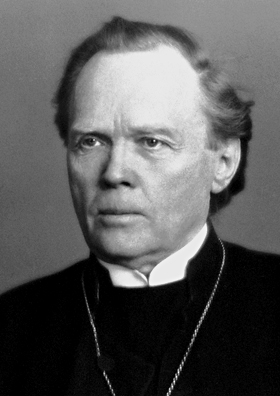Nathan Söderblom facts for kids
Quick facts for kids The Most Reverend Nathan Söderblom |
|
|---|---|
| Archbishop of Uppsala Primate of Sweden |
|
 |
|
| Church | Church of Sweden |
| Diocese | Uppsala |
| Elected | 20 May 1914 |
| In Office | 1914–1931 |
| Predecessor | Johan August Ekman |
| Successor | Erling Eidem |
| Orders | |
| Ordination | 1893 (priest) |
| Consecration | 8 November 1914 by Gottfrid Billing |
| Personal details | |
| Birth name | Lars Olof Jonathan Söderblom |
| Born | 15 January 1866 Trönö, Sweden |
| Died | 12 July 1931 (aged 65) Uppsala, Sweden |
| Nationality | Swedish |
| Denomination | Church of Sweden |
| Parents | Jonas Söderblom and Nikolina Sophie Blûme |
| Spouse | Anna Söderblom (born as Forsell) (1870–1955) |
| Children | 12 |
| Alma mater | Uppsala University |
Nathan Söderblom (born Lars Olof Jonathan Söderblom, January 15, 1866 – July 12, 1931) was an important Swedish clergyman. He served as the Archbishop of Uppsala for the Church of Sweden from 1914 to 1931. An archbishop is a very senior leader in a church. Nathan Söderblom also won the Nobel Peace Prize in 1930. He is remembered in the Lutheran Church on July 12 each year.
Contents
Life and Work
Early Life and Education
Nathan Söderblom was born in a small village called Trönö in Sweden. His father was a local priest. In 1883, Nathan started studying at Uppsala University. At first, he wasn't sure what he wanted to do. But he soon decided to follow his father and become a priest.
After a trip to the United States, he became a priest in 1893. During his time at Uppsala University, he was also a leader of the student union. He was vice president in 1892 and then president in 1893.
Time in Paris and Academia
From 1894 to 1901, Söderblom worked at the Swedish Embassy in Paris. His church group there included famous people like Alfred Nobel and August Strindberg. In 1897, he led the memorial service after Alfred Nobel passed away.
Later, from 1901 to 1914, Söderblom taught at the School of Theology at Uppsala University. He also became a professor of Religious studies at Leipzig University in Germany from 1912 to 1914.
Archbishop and Peacemaker
In 1914, Nathan Söderblom was chosen to be the Archbishop of Uppsala. This made him the head of the Lutheran church in Sweden. During the First World War, he worked hard for peace. He asked Christian leaders everywhere to help bring peace and fairness. He also worked to help prisoners of war and people who had to leave their homes.
Promoting Christian Unity
Söderblom believed that different Christian churches should work together. He thought this unity would help share the message of Jesus with the world. He felt that Jesus' teachings were important for how people live in society.
He led a Christian movement in the 1920s called "Life and Work." This movement helped start the idea of ecumenism. Ecumenism is about different Christian churches working together and understanding each other. He also helped the Church of Sweden and the Church of England become closer. He worked with George Bell, an important English church leader.
In 1925, Söderblom was very important in leading the World Conference of Life and Work in Stockholm. For all his efforts in promoting peace and unity, he was given the Nobel Peace Prize in 1930.
See also
 In Spanish: Nathan Söderblom para niños
In Spanish: Nathan Söderblom para niños
- World Council of Churches
- Ecumenism


